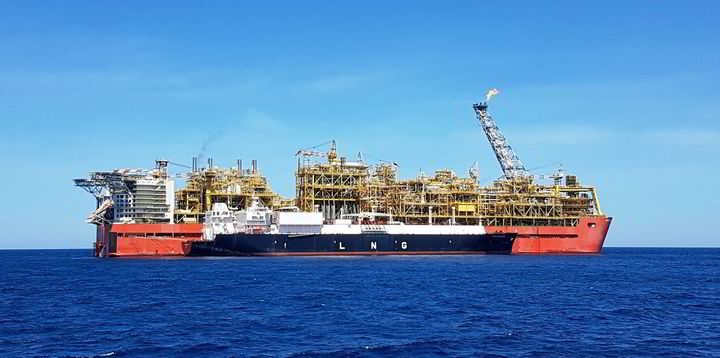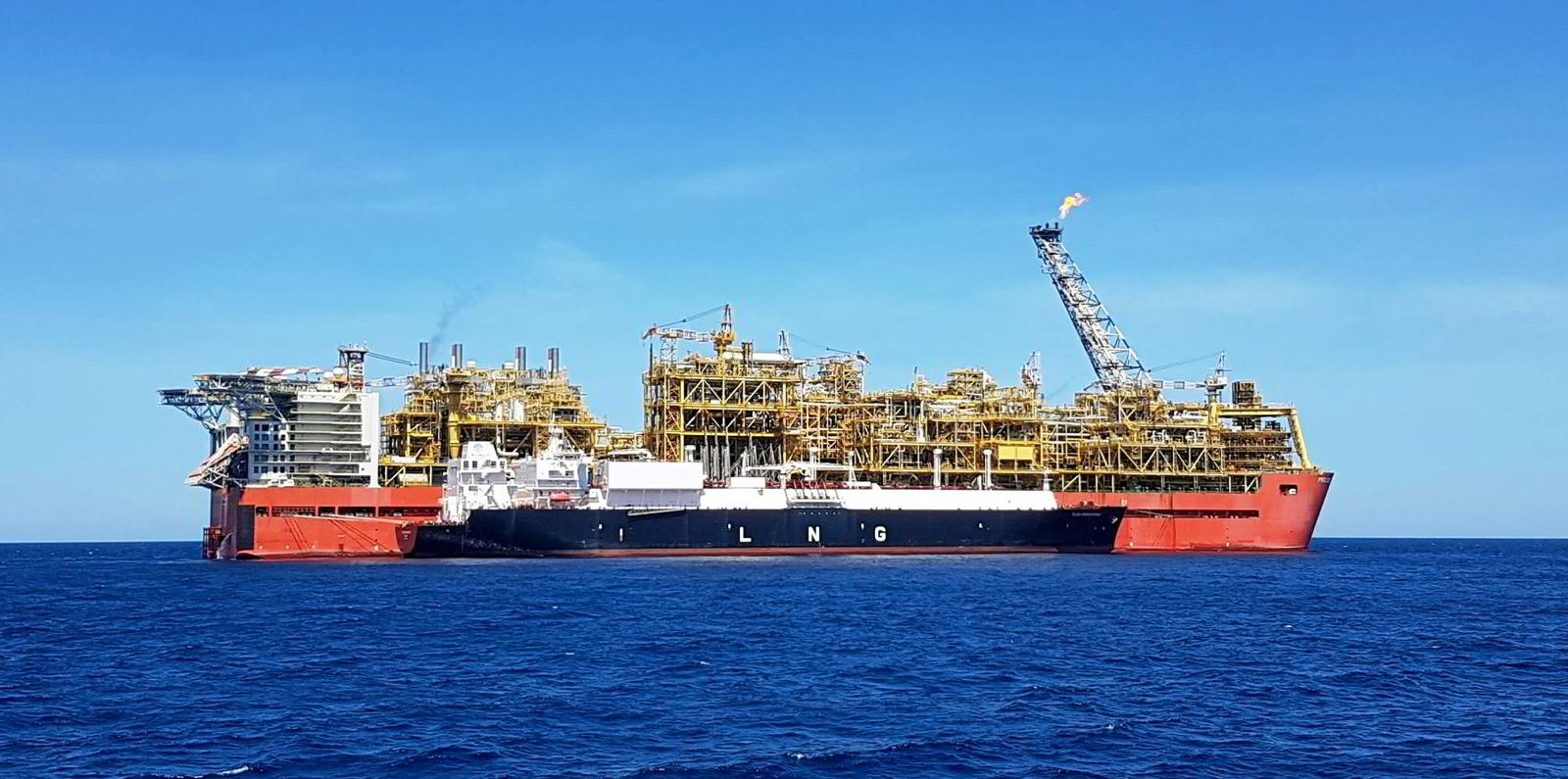The global floating liquefied natural gas sector’s role in transitioning to a low-carbon future has been highlighted by the $35 billion-worth of engineering, procurement and construction contracts forecast to be awarded through to the end of 2027, according to consultancy Westwood Global Energy.
In view of FLNG investments last year and planned investments expected between 2023 and 2027, Westwood anticipates 18.3 million tonnes per annum of additional FLNG capacity to come on stream by 2027, with an associated EPC award value of $13 billion.
A further 36.5 million tpa capacity is anticipated to hit the market after 2027 from FLNG units sanctioned through the end of 2027, with an EPC value of $22 billion.
Although FLNGs offer cost efficiencies compared to onshore LNG alternatives, operators have typically opted to wait for favourable conditions to progress these multi-billion-dollar projects.
With gas prices hitting record highs in 2022 and Europe striving to reduce dependence on Russian pipeline gas imports, the time is nigh for the stuttering FLNG industry to fully bloom, noted Westwood.
Africa in focus
Africa will account for 56% — 10.2 million tpa — of additional FLNG capacity on stream over the 2023-2027 period, with four FLNG units destined for the region currently under construction or reactivation.
Article continues below the advert
The Golar LNG-owned Golar Gimi FLNG unit destined for BP’s Greater Tortue Ahmeyim project offshore Mauritania and Senegal is scheduled to be the first unit delivered in the region over the forecast period.
Production start-up is scheduled for the fourth quarter this year, though its first LNG export cargo is not expected until the first quarter of 2024.
Meanwhile, the Tango FLNG bought by Italian operator Eni last year from Exmar is scheduled to start-up in December 2023 at the Marine XII block offshore Congo-Brazzaville, whilst a second FLNG unit currently under construction at China’s Wison Heavy Industry is expected to be installed on the same block by 2025.
In Gabon, Perenco recently gavce the goa-ahead for a 700,000 tpa FLNG facility to be deployed at the Cap Lopez oil terminal.
Offshore Nigeria, Japan’s JGC is carrying out front-end engineering and design studies on UTM Offshore’s FLNG vessel, which is to be installed in OML 104.
The project is due to be sanctioned in 2024, though UTM is yet to finalise a gas sales agreement with block owners ExxonMobil and state-owned Nigerian National Petroleum Corporation.
Other proposed FLNG facilities anticipated to be sanctioned in Africa over the forecast period include a second unit at Eni’s Area 4 development offshore Mozambique and BP’s Yakaar-Teranga and BirAllah gas discoveries offshore Senegal and Mauritania, respectively.
Mark Adeosun, Westwood’s director for SubseaLogix and PlatformLogix, said it is “pertinent” that Golar LNG “recently secured an option to acquire a 148,000 cubic-metre Moss-design LNG carrier for a 3.5 million tpa” Mark 2 FLNG conversion.
If the unit acquisition completes in the second quarter of this year as planned, “Westwood anticipates that the converted unit could be deployed offshore Africa, with Golar stating that yard availability is confirmed for 2025 delivery and advanced EPC negotiations are under way”, he added.
Opportunities in the Americas
In the US, Delfin Midstream plans to install four FLNG vessels, together producing up to 13.3 million tpa of LNG.
However, despite the completion of FEED studies by Samsung Heavy Industries and Black & Veatch in 2020, Defin has not yet taken the final investment decision and has been granted four one-year extensions to begin construction of onshore metering, compression and pipeline facilities.
Last September, Delfin announced a total of 2.5 million tpa of long-term supply agreements, which it claims is required to begin construction for the first FLNG unit currently planned for start-up this year.
Aside from New Fortress Energy’s plans to host liquefaction plants on converted jack-up rigs and fixed platforms, the US-based LNG player has entered into master service agreements with Singapore’s Sembcorp Marine for the engineering and conversion of two Sevan cylindrical drilling units — Sevan Driller and Sevan Brazil — to FLNG units, including the fabrication and integration of LNG topsides modules.
In Canada, 17.5 million tpa of LNG capacity is in the planning phase across three projects, though Westwood does not anticipate any Canadian projects to begin commercial production before 2028.
Elsewhere, FLNG units are being considered for Chevron’s Leviathan gas field offshore Israel and Transborder Energy’s LNG project offshoreAustralia.
“However, there have been significant delays in deploying these units, with Chevron still evaluating alternative concepts for increasing its gas capacity from the Leviathan project,” noted Adeosun.
Risk of LNG oversupply
Overall, LNG supply growth is expected to increase significantly, especially from the US and Qatar.
Westwood said the current concern is that this will lead to an oversupply in the market and push out riskier and higher cost projects.
This means that each FLNG development must focus on its key qualities to compete, including speed to market and flexibility.
“Furthermore, the use of FLNG units to develop massive gas reserves offshore Mauritania, Senegal, Tanzania and Mozambique is also perceived to be more favourable compared to onshore alternatives, as it represents a lesser security risk to international oil companies,” Adeosun added.
Westwood said the LNG has a generally bright for the coming decade, as it has a vital role to play in Europe, while the increase in coal-to-gas switching and further industrialisation in Asia — primarily India and China — is creating a key growth opportunity for the sector.
“[However], the significant drive to develop renewables and other new energies, such as hydrogen, in Europe and more mature Asian markets — including the traditional LNG demand markets of Japan, Korea and Taiwan, as well as China — could represent a downside risk for the sanctioning of additional FLNG capacity post-2030,” cautioned Adeosun.
When supermajor Shell in 2011 took the final investment decision on its Prelude FLNG project offshore Australia, it was envisaged as the start of an era that would herald the development of stranded gas fields at lower cost.
However, 12 years on, the supposed flood of new units has instead been a trickle and only five FLNG units, with 12.1 million tpa of combined liquefaction capacity, have started commercial operations.
Several FLNG projects have also failed to progress to project sanction, including the Kumul and Western LNG projects offshore Papua New Guinea, Steelhead LNG’s Kwispaa in Canada and the Main Pass Energy Hub in the US Gulf of Mexico.
Despite this, Petronas’ PFLNG Satu (one) and PFLNG Dua (two), Eni’s Coral Sul and Golar LNG’s Hilli Episeyo are today producing, while Shell is once again waiting to restart output from its Prelude FLNG facility, which has been beset with technical problems.

